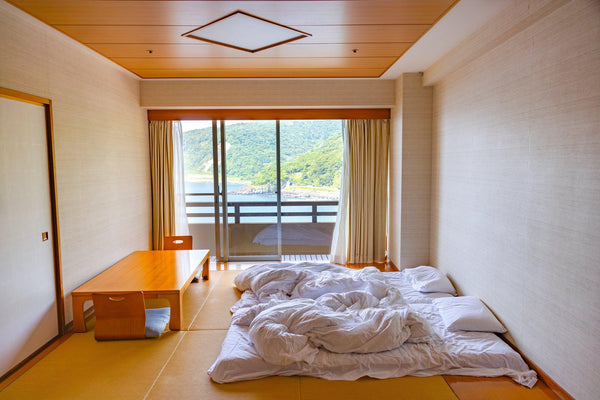
Jump to:
Picture this: you've just arrived in Japan, eager to immerse yourself in the local culture. As night falls, you're led to your room in a traditional ryokan, only to find... no bed? Don't worry, you're not expected to sleep on the bare floor. Instead, you're about to experience one of Japan's most cherished traditions: the futon.
For centuries, Japanese people have been snoozing comfortably on these simple yet ingenious sleeping arrangements. But what exactly is a Japanese futon, and why has it remained a popular choice even in modern times? Let's unroll this cozy mystery and explore the world of Japanese bedding.
What Is A Japanese Futon?

A Japanese futon, or "shikibuton," is a thin mattress that's laid directly on the floor for sleeping.
Unlike its bulky western counterpart, this traditional bedding system is designed to be easily folded and stored away during the day, freeing up valuable space in typically compact Japanese homes.
The history of the Japanese futon dates back to the Edo period (1603-1867), when it evolved from the earlier "shindenzo" bedding used by nobility. As cotton became more widely available, futons gradually replaced straw mats as the preferred sleeping surface for the general population.
A complete Japanese futon set consists of several key components:
- Shikibuton: This is the base mattress, usually about 3-4 inches thick and filled with cotton or synthetic materials. It's placed directly on the floor or a tatami mat.
- Kakebuton: Think of this as the Japanese equivalent of a comforter or duvet. It's a thick, quilted blanket that keeps you warm and cozy throughout the night.
- Makura: No bed is complete without a pillow! Traditional Japanese pillows, or makura, were often small and firm, filled with buckwheat hulls. However, modern versions come in various shapes and materials.
- Tatami: While not strictly part of the futon itself, tatami mats are often used as a base for the shikibuton. These woven straw mats provide a bit of cushioning and help regulate humidity, creating an ideal sleeping surface.
The beauty of this system lies in its simplicity and versatility. During the day, the futon can be folded up and stored in a closet called an "oshiire," instantly transforming the sleeping area into a multi-purpose living space. This efficient use of space reflects the Japanese philosophy of minimalism and functionality in home design.
But the significance of the futon goes beyond mere practicality. In Japanese culture, the act of laying out and putting away the futon each day is often seen as a meditative practice, a moment to transition between rest and activity. It's a daily ritual that connects modern Japanese people to their cultural heritage, even as western-style beds become more common in urban areas.
The next time you find yourself faced with a futon in Japan (such as in a ryokan or capsule hotel), don't be intimidated. Instead, embrace the opportunity to literally immerse yourself in Japanese culture. Who knows? You might just have the best sleep of your life!
Characteristics And Appeal Of Japanese Futons

Ever wondered why many Japanese people still choose to sleep on futons despite the availability of western-style beds? The answer lies in a combination of practicality, health benefits and cultural preference.
One of the primary advantages of a Japanese futon is its space-saving design. In a country where living spaces can be notoriously compact, the ability to fold up your bed and tuck it away is a game-changer. It's like having a secret home superpower that transforms your bedroom into a living room in minutes!
But the futon concept is not just about saving space.
Many Japanese people swear by the health benefits of sleeping on a firmer surface. The theory goes that a harder sleeping surface helps maintain proper spinal alignment, potentially reducing back pain and improving posture. While scientific evidence on this is mixed, countless futon enthusiasts can't be wrong, right?
There's also something to be said for sleeping closer to the ground. It can make you feel more connected to the earth, fostering a sense of grounding that many find calming. Plus, in the sweltering Japanese summers, being lower down where it's cooler can make for a more comfortable night's sleep.
Let's not forget the versatility factor. Having guests staying the night (or longer)? No problem - just pull out a couple more futons, and you’ve got a sleepover.
Japanese vs. Western Futons: Understanding The Differences

Now, if you're picturing that clunky sofa-bed contraption in your college dorm room when we say "futon," it's time for a reality check. Japanese and western futons are about as similar as sushi and a hamburger. While they might share a name, that's where the similarities end.
A Japanese futon, as we've discussed, is a thin, portable mattress designed to be placed directly on the floor. It's all about simplicity and flexibility.
On the other hand, a western futon is typically a bulky piece of furniture that serves as both a couch and a bed. It's the Swiss Army knife of furniture, if you will.
While a Japanese futon is meant to be stored away during the day, its western counterpart is a permanent fixture in the room. The Japanese version prioritizes space-saving and minimalism, while the western interpretation focuses on multi-functionality.
Another key difference lies in the comfort level. Japanese futons are generally firmer, promoting that straight-spine sleeping position we mentioned earlier. western futons, while still firmer than traditional mattresses, often aim for a middle ground between sofa and bed comfort.
The Western Futon: Components & Benefits

What exactly makes up a western futon? Typically, you'll find a frame (usually made of wood or metal), a mattress and sometimes a cover. The frame allows the futon to transform from a sofa to a bed, often with a simple folding mechanism.
The mattress is where things get interesting. Unlike the thin Japanese shikibuton, western futon mattresses are thicker and often filled with a combination of materials like cotton, polyester and foam. This makes them more comparable to traditional western mattresses in terms of comfort.
One of the main benefits of a western futon is its dual functionality. It's perfect for small apartments or guest rooms, offering seating by day and sleeping space by night. Plus, many find the firmer surface beneficial for their backs, much like their Japanese counterparts.
Origins Of The Western Futon

How did this Japanese sleeping tradition evolve and morph into a dorm room staple in the West?
Well, it's quite a journey!
The western futon as we know it today was pioneered by William Brouwer, an American furniture designer, in the late 1960s. Inspired by the Japanese original, Brouwer created a wooden frame that could convert from a couch to a bed, paired with a thicker, more cushioned mattress.
The term "futon" was adopted for this new piece of furniture due to its Japanese inspiration, even though it had evolved into something quite different. The concept caught on quickly, especially among college students and young adults looking for affordable, space-saving furniture options.
By the 1980s, futons had become a mainstream furniture item in the West, with various designs and styles available. While they may have strayed far from their Japanese roots, they've carved out their own niche in western furniture design.
Caring For Your Japanese Futon

If you've fallen in love with the idea of a Japanese futon and are considering getting one, it's important to know how to care for it properly.
A well-maintained futon can last for years!
First things first: airing out your futon is crucial. In Japan, it's a common sight to see futons hanging over balcony railings on sunny days. This exposure to sunlight and fresh air helps prevent moisture buildup and keeps your futon fresh and hygienic. You can also use a roller (such as this one from Nippon Seal) to remove dust, hair and other particles from the futon.
When it comes to cleaning, most futons can be spot-cleaned with a mild detergent for small stains. For a deeper clean, it's best to take your futon to a professional cleaner who specializes in Japanese bedding.
Storing your futon properly is equally important. Always make sure it's completely dry before folding it up. Store it in a well-ventilated area, preferably in a breathable cotton bag to protect it from dust while allowing air circulation.
Is A Futon In Your Future?
If you're planning a trip to Japan, there’s a pretty good chance you’ll get the futon experience at some point during your visit here.
Looking to bring a bit of Japanese culture into your home? A futon is a fine way to do just that. Now that you know the differences between western and Japanese futons, you’ll be able to make the right choice for your bedding needs.


0 comments